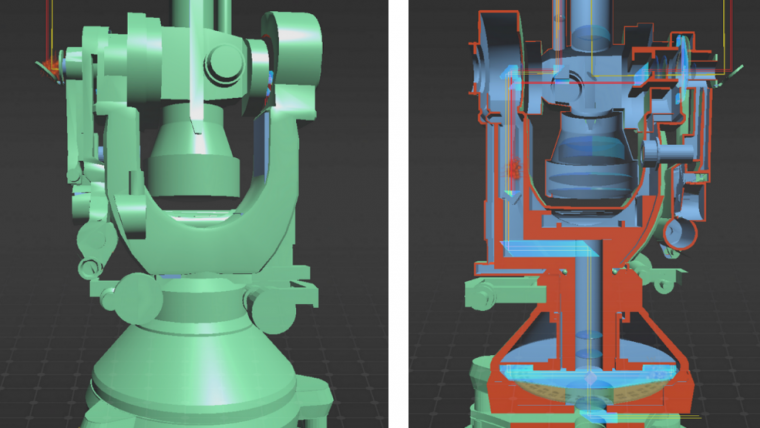Bringing History to Life Using 3D Interactive Computer Graphics
App Celebrates 100 Years of Innovation at Heerbrugg
A recent project has celebrated 100 years of geodetic and photogrammetric innovation by 3D-digitizing an iconic WILD T2 theodolite from the 1927 series. An app has also been developed for Android, iOS and Windows devices.
Modern didactic and historical research related to digital humanities requires 3D digitization and dynamization of tech heritage. One example of such a project is the decision to celebrate 100 years of great innovations in the development of geodetic and photogrammetric instruments by 3D digitizing an iconic WILD T2 theodolite from the 1927 series and developing an app for Android, iOS and Windows devices.
WILD Heerbrugg, which is today owned by Leica Geosystems, part of Hexagon, celebrated its centenary earlier this year. It all started in late autumn 1920 with a telegram from Heinrich Wild, at that time head of the Geodetic Instruments Department at Carl Zeiss, Jena, Germany, to Dr Robert Helbling, a mountaineer, mountain cartographer and owner of a surveying office in Flums, Switzerland: “I have designed a new autograph for the photogrammetric production of maps, which will be much cheaper than the model currently on the market”. In search of a sponsor to establish a new company, Dr Helbling approached Jacob Schmidheiny, an influential and highly respected entrepreneur from the Alpine Rhine Valley. After extensive contract negotiations, the partnership agreement for the new company called ‘Heinrich Wild, Werkstätte für Feinmechanik und Optik, Heerbrugg’ was signed on 26 April 1921. The new company started with about 30 employees.
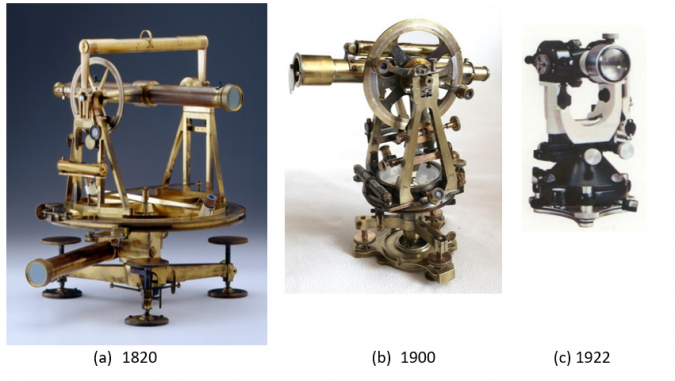
In addition to designing the autograph, Heinrich Wild began designing and building a photo theodolite and, simultaneously, the world-famous T series: the T1, T2 and T3. The WILD T2 was designed as a universal theodolite, with an angular measurement precision of 1 arc-second and revolutionary features. Previous arc-second or so-called ‘repetitive’ theodolites were large and difficult to use (Fig. 1), so the T2 soon became popular. In fact, more than 90,000 units were sold over seven decades. So what made the WILD T2 so special?
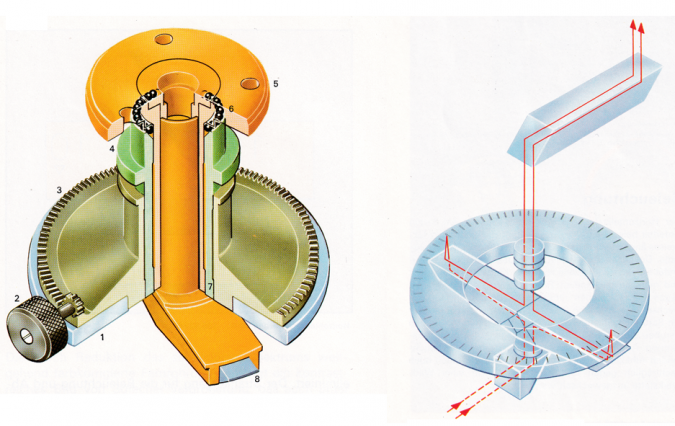
About the WILD T2
When designing the T2 theodolite as a further improvement of the ZEISS T1, the following features were important to Heinrich Wild:
- Very compact telescope with 24x magnification, internal focusing lens and to be illuminated.
- Cylindrical standing axis made of hardened steel and mounted on ball bearings (Fig. 2a)
- Glass circles with 1 arc-second reading precision and therefore very precise etching of the graduation lines (0.15μm) (Fig. 2b)
- Coincidence microscopes for horizontal and vertical circles for reading diametrical pitch circle locations (Fig. 3b)
- Very compact and closed housing weighing about 4.5kg
- Dust-tight container for easy transport
The coincidence microscope for reading the two diametral pitch circle positions was realized by a plane plate micrometer and achieved significant time savings compared to the reading of only one pitch circle position (Fig. 3a).
In 1923, the first 24 instruments were delivered, despite adverse conditions in series production. Difficulties included the production of the horizontal circles (d=90mm) and vertical circles (d=70mm). These were made of glass, which was a novelty at that time as they had previously been made of brass. The first devices were delivered in noble black/white (about 1,800 pieces). The transition to the classic WILD green happened in 1927.
In response to sustained worldwide demand, the WILD T2 continued to be produced until 1995 and was adapted to technological progress over the decades. For example, partial digitization of the glass circles in 1972 avoided errors in the ten-minute readings.
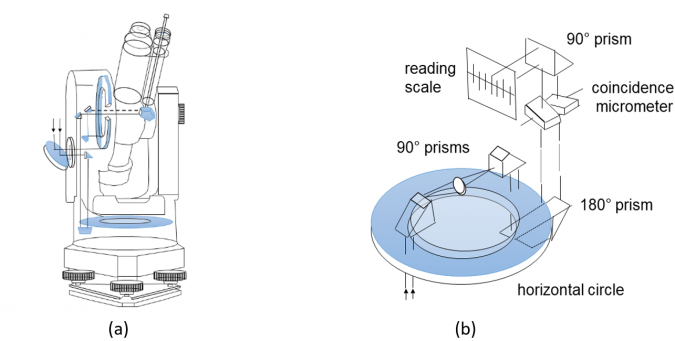
Designing the WILD T2 App
It is widely recognized that animated and dynamic models help to foster a better understanding of design elements, to digitally open up information to members of the public and to inspire youngsters about possible areas of study or future career options. This newly emerging form of didactics is also known as ‘education entertainment’ or ‘edutainment’. This form of presentation and visualization will almost certainly help to spark young people’s interest and fascination in 3D digitization technology, tech heritage preservation activities and perhaps even geodetic instrumentation. Therefore, in the summer of 2020, the three authors decided to develop an interactive 3D app presenting the iconic WILD T2.
First of all, a storyboard was created to provide guidance throughout all stages of the app design. It tells 15 stories in total – including about the foundation of the company, the features of the WILD T2 and the interior elements of the theodolite. Embedded in the historical text are audio messages, images and static and animated 3D models. The animations are generated by 3D interactive computer graphic, to keep users interested in the various stories and to highlight some important features. The app is available in German, English and Chinese (Mandarin) (Fig. 4).

The 3D digitization was based on a 1927-series WILD T2. It was scanned by a composite of up to 800 photos and transformed into a coloured 3D point cloud by photogrammetric bundle block adjustment (based on structure from motion, SfM) and dense image matching (DIM) (Fig. 5).
Since the coloured point cloud of the WILD T2 was about 600MB in size, it could not serve as 3D base model in the app. Therefore, a transformation process was necessary to convert the point cloud into a vectorized 3D model. Techniques to automatically transform point clouds into kinematic 3D models, e.g. using machine learning (ML) and deep learning (DL) methods, are still in the early stages and therefore have very limited application, although that may change fundamentally in the next five to ten years. In this case, the point cloud was transformed into 3D CAD elements in an interactive computer graphics process called constructive solid geometry (CSG). This breaks down the point cloud model into its vectorial components and these are then textured accordingly (Fig. 6). The CSG 3D model could then be textured with the WILD T2 texture from the past decades, animated and dynamized as desired: rotation around the alidade axis, telescope traversal, tilted and zoomed. Moreover, a decomposition into the optical components (using sectional drawings) allows for camera flights along the ray paths for the horizontal and vertical circles, representation of axes systems, and much more. Users of the app user can also play around with the 3D virtual reality (VR) model – or ‘digital twin’ – of the T2.
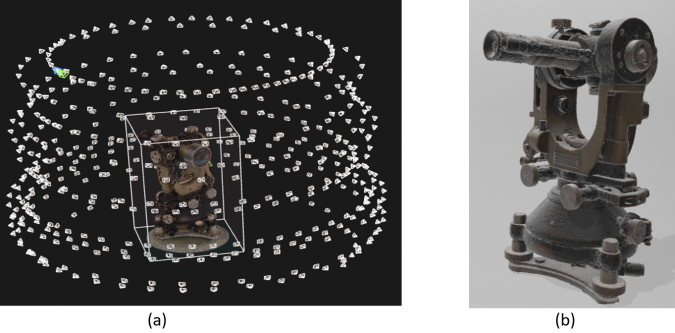
The app operates in panoramic mode and the screen is subdivided into three parts: the story headings on the left, the stories with images in the middle and the help symbols on the right. 3D models and animations are displayed in the middle of the screen and symbolized by the rotating cube symbol. The buttons on the top left lead to the story headings and to the home screen. Audio embedded in the corresponding stories can be activated using the loudspeaker button. The 15 stories provide app users with a comprehensive overview of the company history and its locations over time, the T2 features and updates, and some interior elements of the theodolite which are animated to demonstrate its compact and revolutionary design.
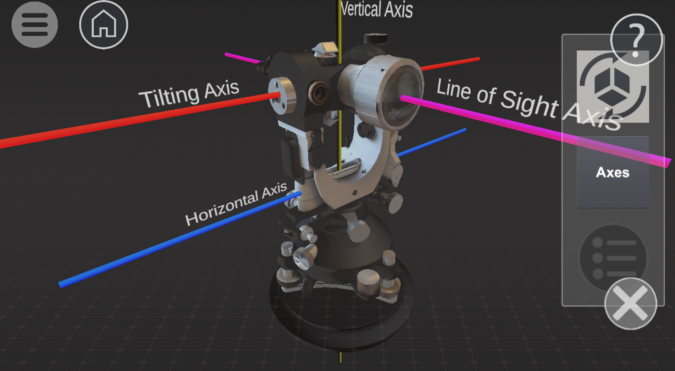
Animations and Rendering
All interactive computer graphics 3D models have been generated using Autodesk 3ds MAX. The point clouds were used only for scaling the final 3D CSG model. The photos of the T2 over time (1923-1995) served for texturing the digital twins, according to a selected point in time. The app offers three digital twins for the following time periods: 1922, 1929 and 1962. Several cross-section models (one of which is shown in Fig. 7) were used to create a very detailed 3D model with numerous design elements, which the user can also ‘explode’. This feature is aimed at inspiring the younger generation about the possibilities of interactive computer graphics, which can also be used to provide impressive animations and simulations in sectors where 3D data capture is emerging, such as architecture, engineering & construction (AEC).
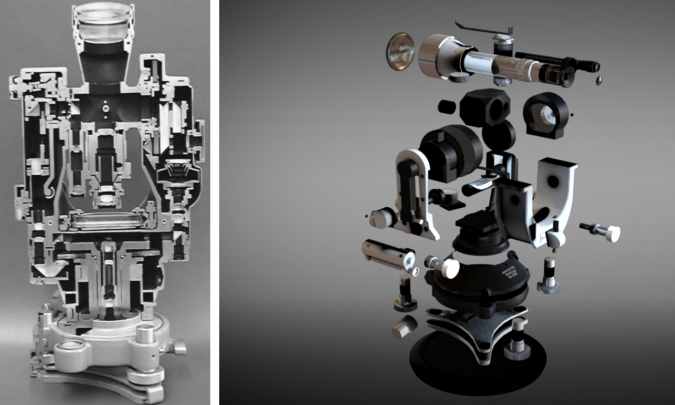
The 3D text, audio, image sequences and 3D models were integrated into the app using the Unity 3D game engine. This enabled the animated interactive 3D models to be exported and rendered and finally prepared for mobile operating systems, such as Android and iOS. During this processing step, a Windows version was also generated to be scaled for several screen resolutions. Fig. 8 shows an excerpt from Story 15, featuring animated flights through the optical systems for reading the horizontal and vertical circle.
Conclusion
The WILD T2 theodolite was a milestone in geodetic instrument development. For more than seven decades, it had the most modern design and revolutionary features of its time, such as the cylindrical standing axis, horizontal and vertical circles made of glass, diametrically readable graduated circles, precise readings by coincidence micrometers, a compact telescope and low weight. By summarizing the most important facts and features of this innovative and bestselling theodolite, the WILD T2 app recognizes the outstanding performance of the engineers, technicians and managers at Heerbrugg, within the company that is today known as Leica Geosystems and part of Hexagon – over the past 100 years. The developers hope that the WILD T2 app will contribute to the public understanding of science and technology by presenting 15 stories about the background of WILD Heerbrugg and the T2 including a variety of 3D reconstructions, visualizations, animations, image sequences and audio. In these times of digitalization and new didactic elements in higher education, it is hoped that the app will help students and also the general public to gain a better understanding of the history of geodesy and geoinformation science through the playful use of new technologies.
Further Reading
Download the WILD T2 app free of charge:
Android: https://play.google.com/store/apps/details?id=net.sreasons.WILDT2
iOS: https://apps.apple.com/us/app/wild-t2/id1564103981
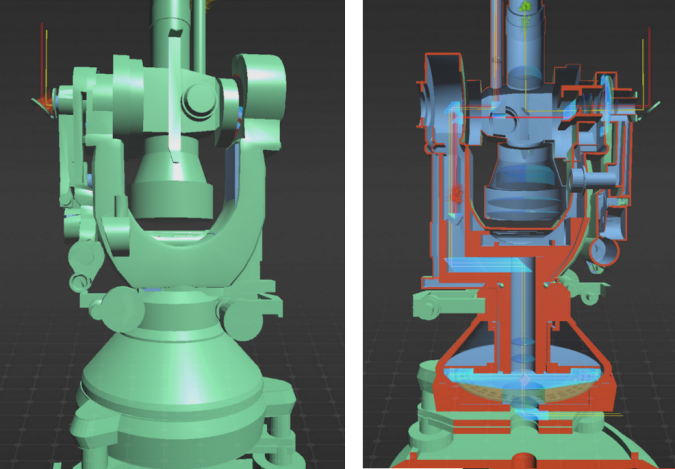

Value staying current with geomatics?
Stay on the map with our expertly curated newsletters.
We provide educational insights, industry updates, and inspiring stories to help you learn, grow, and reach your full potential in your field. Don't miss out - subscribe today and ensure you're always informed, educated, and inspired.
Choose your newsletter(s)
